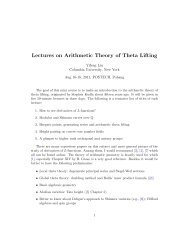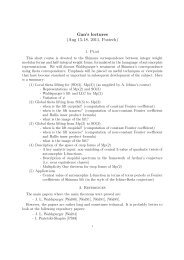MODULARITY LIFTING THEOREMS - NOTES FOR POSTECH ...
MODULARITY LIFTING THEOREMS - NOTES FOR POSTECH ...
MODULARITY LIFTING THEOREMS - NOTES FOR POSTECH ...
You also want an ePaper? Increase the reach of your titles
YUMPU automatically turns print PDFs into web optimized ePapers that Google loves.
8 TOBY GEE<br />
If in addition we have F = Q, then we furthermore demand that for<br />
all g ∈ GD(A ∞ ), h∞ ∈ GL2(R) + the function φ(gh∞)|ℑ(h∞i)| k/2<br />
is bounded on C − R.<br />
There is a natural action of GD(A ∞ ) on SD,k,η by right-translation, i.e.<br />
(gφ)(x) := φ(xg).<br />
Exercise 2.1. While this definition may at first sight appear rather mysterious,<br />
it is just a generalisation of the familiar spaces of cuspidal modular<br />
forms. For example, take F = Q, S(D) = ∅, k∞ = k, and η∞ = 0. Define<br />
U1(N) = {g ∈ GL2( ˆ � �<br />
∗ ∗<br />
Z)|g ≡ (mod N)}.<br />
0 1<br />
(i) Let GL2(Q) + be the subgroup of GL2(Q) consisting of matrices with<br />
positive determinant. Show that the intersection of GL2(Q) + and<br />
U1(N) inside GL2(A∞ � �<br />
) is Γ1(N), the matrices in SL2(Z) congruent<br />
1 ∗<br />
to (mod N). [Hint: what is<br />
0 1<br />
ˆ Z × ∩ Q × ?]<br />
(ii) Use the facts that GL2(A) = GL2(Q)U1(N) GL2(R) + [which follows<br />
from strong approximation for SL2 and the fact that det U1(N) =<br />
ˆZ × ] and that A × = Q × Z ˆ× ×<br />
R >0 to show that S U1(N)<br />
D,k,0 can naturally be<br />
identified with a space of functions<br />
satisfying<br />
φ : Γ1(N)\ GL2(R) + → C<br />
φ(gu∞) = j(u∞, i) −k φ(g)<br />
for all g ∈ GL2(R) + , u∞ ∈ R × >0 SO(2).<br />
(iii) Show that the stabiliser of i ∈ in GL2(R) + is R × >0 SO(2). Hence deduce<br />
a natural isomorphism between S U1(N)<br />
D,k,0 and Sk(Γ1(N)), which<br />
takes a function φ as above to the function (gi ↦→ j(g, i) kφ(g), g ∈ GL2(R) + .<br />
The case that S∞ ⊂ S(D) is particularly simple; then if U ⊂ GD(A∞ ) is<br />
open, SU D,2,0 is just the set of C-valued functions on<br />
GD(Q)/GD(A)/GD(R)U,<br />
which is a finite set.<br />
We will now examine the action of Hecke operators on these spaces.<br />
Choose an order OD ⊂ D (that is, a Z-subalgebra of D which is finitely<br />
generated as a Z-module and for which OD ⊗Z Q ∼ −→ D). For example, if<br />
D = M2(F ), one may take OD = M2(OF ).<br />
For all but finite many finite places v of F we can choose an isomorphism<br />
Dv ∼ = M2(Fv) such that this isomorphism induces an isomorphism OD ⊗OF<br />
∼<br />
OFv −→ M2(OFv). Then GD(A∞ �<br />
) is the subset of elements g = (gv) ∈<br />
v∤∞ GD(Fv) such that gv ∈ GL2(OFv) for almost all v.




